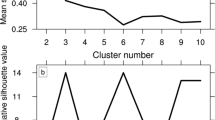Abstract
Cluster analysis has been performed on the tracks of 51 Tropical Cyclones (TCs) that made landfall on the Korean Peninsula (KP) for the period of 1951–2004. The classification technique of the landfalling tracks used in this study was the fuzzy clustering method (FCM) and the resultant silhouette coefficient suggested four clusters as an optimal cluster number. Most TCs of Cluster 2 and Cluster 3 (C-23) tended to pass through mainland China before landfall, but those of Cluster 1 and Cluster 4 (C-14) tended to mostly land after moving northward from the East China Sea (ECS) without passing over mainland China. The TC landfalling frequency of C-14 has begun to clearly increase since the late 1980s, particularly the maximum landfalling frequency in the early 2000s set a record for the 54-year analysis period. The ridge axis of the western North Pacific high (WNPH) of C-23 bends more equatorward than that of C-14, so that the monsoon trough of C-23 is located more equatorward than that of C-14. As a consequence, most TCs of C-23 tend to recurve inland of China, but over the ECS for C-14.
Similar content being viewed by others
References
Camargo, S. J., A.W. Robertson, S. J. Gaffney, P. Smyth, and M. Ghil, 2005: Cluster analysis of western North Pacific tropical cyclone tracks. J. Climate, 20, 3654–3676.
Harr, P. A., and R. L. Elsberry, 1991: Tropical cyclone track characteristics as a function of large-scale circulation anomalies. Mon. Wea. Rev., 119, 1448–1468.
Hodanish, S., and W. M. Gray, 1993: An observational analysis of tropical cyclone recurvature. Mon. Wea, Rev., 121, 2665–2689.
Jeong, J.-S., 1991: A mesoscale numerical model simulation study of the tropical cyclone Vera using bogus typhoon. Ph. D. dissertation, Seoul National University, 48pp.
Kalnay, E., and Coauthors, 1996: The NCEP/NCAR 40-year reanalysis project. Bull. Amer. Meteor. Soc., 77, 437–471.
Kaplan, J., and M. DeMaria, 1995: A simple empirical model for predicting the decay of tropical cyclone winds after landfall. J. Appl. Meteor., 34, 2499–2512.
Kaplan, J., and M. DeMaria, 2001: On the decay of tropical cyclone winds after landfall in the New England area. J. Appl. Meteor., 40, 280–286.
Kaufman, L., and P. J. Rousseeuw, 1990: Finding Groups in Data. A Wiley-Interscience Publication, 164pp.
Kim, J.-H., and C.-H. Ho, 2005: A study on the seasonal typhoon activity using the statistical analysis and dynamic modeling. Ph. D. dissertation, Seoul National University, 240pp.
Kim, Y.-J., 1993: A research on the design and effects of bogus typhoon for the improvement of typhoon forecast. Ph. D. dissertation, Seoul National University, 174pp.
Kistler, R., and Coauthors, 2001: The NCEP/NCAR 50-year reanalysis. Bull. Amer. Meteor. Soc., 82, 247–267.
Korea Meteorological Administration, 1996: Typhoon White Book, 22pp.
Korea Meteorological Administration, 2002: Analysis of the characteristic of the 15th typhoon “RUSA”, 121pp.
Lander, M. A., 1996: Specific tropical cyclone track types and unusual tropical cyclone motions associated with reverse-oriented monsoon trough in the western North Pacific. Wea. Forecasting, 11, 170–186.
Lee, D. K., D. E. Jang, and T. K. Wee, 1992: Typhoon approaching Korea, 1960-1989 Part I: Statistics and synoptic overview. Journal of the Korean Meteorological Society, 28, 133–147. (in Korean)
Park, J. K., B. S. Kim, W. S. Jung, E. B. Kim, and D. G. Lee, 2006: Change in statistical characteristics of typhoon affecting the Korean Peninsula. Atmosphere, 16, 1–17. (in Korean)
Powell, M. D., P. P. Dodge, and M. L. Black, 1991: The landfall of hurricane Hugo in the Carolinas: Surface wind distribution. Wea. Forecasting, 6, 379–399.
Roy Bhowmik, S. K. R., and S. R. Kalsi, 2005: An empirical model for predicting the decay of tropical cyclone wind speed after landfall over the Indian region. J. Appl. Meteor., 44, 179–185.
Sohn, K.-T., J.-S. Baik, H.-A. Kim, and J.-H. Oh, 1998: Analysis of typhoon track patterns using the statistical multivariate data analysis. Journal of the Korean Meteorological Society, 34, 346–354. (in Korean)
Youn, Y-.H., and C.-K. Kim, 1999: Analysis of the characteristics of storm surges according to the typhoon path. Journal of the Korean Meteorological Society, 35, 344–353. (in Korean)
Author information
Authors and Affiliations
Corresponding author
Rights and permissions
About this article
Cite this article
Choi, KS., Kim, BJ., Choi, CY. et al. Cluster analysis of Tropical Cyclones making landfall on the Korean Peninsula. Adv. Atmos. Sci. 26, 202–210 (2009). https://doi.org/10.1007/s00376-009-0202-1
Received:
Revised:
Published:
Issue Date:
DOI: https://doi.org/10.1007/s00376-009-0202-1




